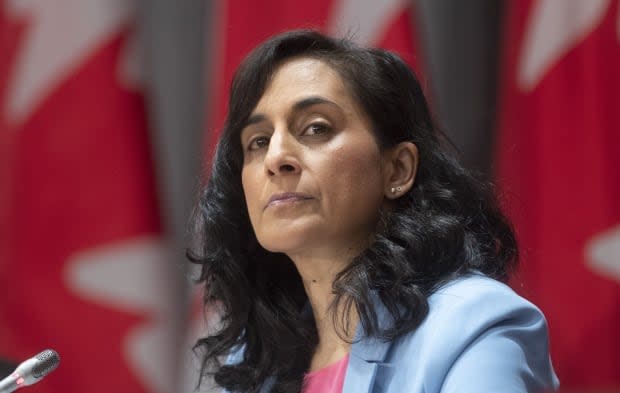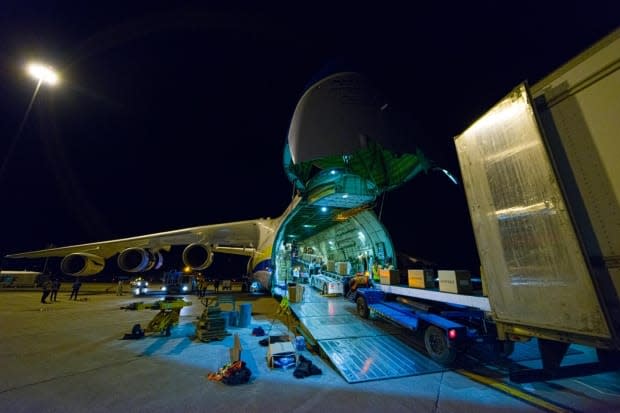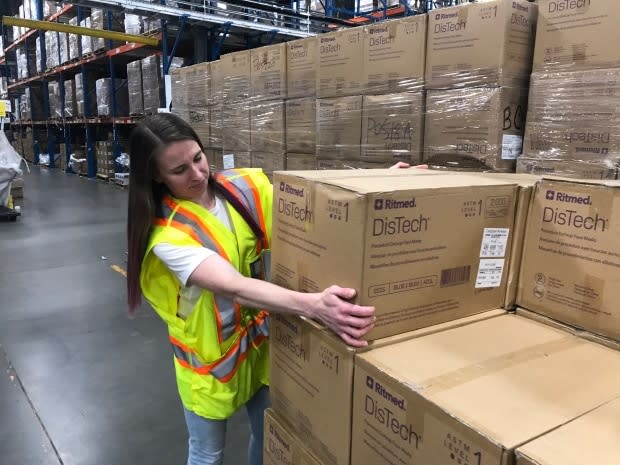The great PPE panic: How the pandemic caught Canada with its stockpiles down
This is the fourth in a series of articles looking at some of the lessons learned from the first months of the COVID-19 pandemic and how Canada moves forward.
To hear Minister of Public Services and Procurement Anita Anand describe it, Canada's effort to supply frontline workers during the pandemic has been a significant — if uneven — success.
"We did procurement like it has never been done before," said Minister of Public Services and Procurement Anita Anand. "We are in an urgent scramble to secure personal protective equipment and we will not let up until that task is accomplished."
The federal government, she said, has conducted just under a hundred flights to Canada carrying Chinese personal protective equipment (PPE) and bringing supplies from the U.S. and Europe.
It was a remarkable, last-ditch effort. But could it have been avoided?

Dr. Sandy Buchman, president of the Canadian Medical Association, gives Ottawa credit for pulling every lever it could when the need for PPE became critical. "But they wouldn't have had to scramble to do that if we had adequate stockpiles, and the same goes for medication," he told CBC News. "We should have maintained and had them available.
"We had a pandemic plan in place but we didn't actually have things ready. We didn't have adequate personal protective equipment for frontline health care workers."
In fact, Canada still doesn't have the PPE it needs to keep those essential workers safe.
Read more from the series:
Just take a look at the nation's capital. Thirty out of some 600 Ottawa paramedics are currently reassigned from front-line duties because of a lack of N95 masks, according to their union.
CUPE ambulance rep Jason Fraser told CBC News that when he began as a paramedic during the SARS epidemic in 2003, he and his co-workers were fitted out with state-of-the-art respirators.
"For 17 years, the gold standard of mask has been the N95 masks," he said. "And due to a global shortage or difficulty obtaining proper PPE, all of a sudden surgical masks are OK protection."
Fraser said his members don't want to work with anything less than N95s and don't believe they'd be asked to do so were it not for preventable shortages.
He points the finger of blame mainly at the Ontario government. But a shortage of N95s has been an issue in many places across the country.
PPE stock in poor shape
Canada's pandemic response got off to a rocky start when it came to the basic tools: masks, gowns, gloves and other products.
Canadian PPE stockpile levels were woefully low when the pandemic hit; materials were allowed to expire without being used or even donated, and then ended up in landfills. The Trudeau government was widely criticized for sending 16 tons of PPE to China at a time when the novel coronavirus was still mostly a Chinese problem, and the Public Health Agency of Canada was still mistakenly assessing the risk to Canadians as "low."

Anand said her department responded to those shortages by fostering the creation of a Canadian PPE industry from scratch.
"Forty-four per cent of our contracts by dollar value are made with domestic manufacturers," she said.
"This is an incredible effort on behalf of Canadians themselves to protect Canadians. So that is a heartening story and it's also an important lesson learned."
It's a lesson nearly everyone involved in fighting the pandemic agrees has to be learned — if Canada wants to avoid the same experience when the next pandemic hits.
The preppers weren't prepared
One nation that hasn't had to worry about PPE is Finland. Its history of Soviet invasion left it with a siege mentality that manifested itself in the construction of a secret network of bunkers stocked with supplies to carry its people through times of war or disaster — including a huge stockpile of masks.
Canada also has a National Emergency Stockpile System (NESS), launched in 1952 at the height of the Cold War and originally intended to help Canada survive a nuclear attack.
Lately, the system's rationale has changed somewhat. "We began to move away from beds and blankets and increased our holdings of antiviral medications and key treatments," Sally Thornton of the Public Health Agency of Canada told MPs at a committee hearing in May.
"We do not focus on PPE and that wouldn't be a major element, because we count on our provinces, within their respective authority, to maintain their stockpile."
Some MPs found that answer highly unsatisfactory, given that the NESS last year threw out two million N95 masks that had been allowed to expire.
Stockpile 'completely unready'
"The stockpile system proved completely unready for COVID-19, and the degree of unreadiness goes well beyond the explanation that COVID-19 was was unexpected in terms of its impact and scale," said Wesley Wark of the University of Ottawa, an intelligence expert who studied the NESS's response to the pandemic.
"It was clearly underfunded. Cabinet ministers and senior officials have admitted that fact."
Health Minister Patty Hajdu said in April that "federal governments for decades have been underfunding things like public health preparedness, and I would say that obviously governments all across the world are in the same exact situation."

What Hajdu said is true — although her own government closed warehouses and left the stockpile even smaller than it found it. NESS's annual budget is only about $3 million and both the Harper and Trudeau governments routinely spent even less on it. It has a regular staff of just 18 people.
"But beyond its underfunding," said Wark, "it basically lacked any kind of strategy as far as I can tell to prepare for an emergency ..."
"There was really no planning done to integrate the federal government's stockpile system with those held by the provinces and territories. It's not until February — a month into the COVID-19 crisis — [that] the federal government wakes up to the fact that they don't even know what is held in provincial and territorial stockpiles, nor do provinces and territories know what's held in the federal stockpile. That points to a basic strategic failure."
The come-as-you-are pandemic
When March arrived, Wark said, "the stockpile system had to transition into being a kind of portal for trying to get supplies hastily mobilized from domestic suppliers or international sources into Canada and passed on to provinces and territories.
"You know, I think the whole thing was just a desperate scramble. And it didn't need to have been that way, if proper attention had been paid to the important role that the stockpile system was meant to play."
A pandemic is a bad time to start shopping for emergency supplies. With COVID-19 engulfing one country after another, Canada found itself competing with dozens of other countries, as well as private U.S. hospital networks, to acquire the most sought-after items.
Anand said the government has learned that lesson and will ensure that stockpiles of PPE, medicines and other essentials are maintained in future.
Stockpiles alone won't solve the problem, she said, because PPE products have expiry dates and a major pandemic would at least start to exhaust any stockpile.
"Another part of the puzzle is also to make sure that we've got relationships with a diverse range of suppliers who can produce these goods so that we have priority when it comes to making sure that we have that product," she said.
Unreliable suppliers
Canada's two main markets for acquiring PPE supplies — the U.S. and China — have been problematic.
China's PPE market quickly flooded with new companies that previously had been making things like baby toys or auto parts. They began to churn out PPE of wildly varying quality.
In the U.S., President Donald Trump ordered 3M to stop fulfilling contracts to provide N95 masks to other countries, and halted a shipment to Ontario in April. Thanks mainly to dogged resistance to that order by 3M executives, the threat was averted.

But it it all served as a reminder of the risks involved in depending on other countries for essential supplies in a global emergency. Ontario Premier Doug Ford vowed to make his province self-sufficient.
"I'm not going to rely on President Trump," he said. "I'm not going to rely on any prime minister of any country ever again. Our manufacturing, we're gearing up and once they start, we're never going to stop them."
Anand said she is working to end Canada's dependence on foreign sources.
"The strategy from procurement has been to diversify our supply chains to make sure that we are not reliant on one country or one jurisdiction alone," she said.
"We would very much aim to have domestic production of every item here in Canada."
That would mean persuading the Canadian manufacturers that switched production over to medical equipment — such as clothing maker Stanfields in Nova Scotia — to stay in the game once the crisis passes.
Mixed messages on masks
The government's early advice against wearing masks confused many Canadians, who suspected (correctly, as it turned out) that the guidance defied common sense.
That confusion also affected people in the medical field.
"I have been astounded that we are not being told to wear masks," one occupational therapist told CBC News on March 31, describing conditions at the rehab hospital where she worked. "We are even being told we can't wear our own masks and will be reprimanded and potentially disciplined for doing so."
Some Canadian hospitals even had security guards order people to remove masks before they could enter.

Calgary ER physician Joe Vipond told CBC News the government's position on masks struck him as irrational from the beginning.
"And I see that changing, but boy it's slow!" he said.
He said that his own province of Alberta was "pretty late to the PPE bandwagon".
"I know in B.C. on March 25 every single hospital and every single long term care facility were mandated to wear masks in all situations, in order to avoid pre-symptomatic and asymptomatic spread," he said.
In Alberta, he added, that decision came "a good three weeks after. And so I think a lot of ways we were quite lucky to avoid a lot of transmission within our acute care facilities. That didn't work out so well for our long term care facilities.
"I know there was one outbreak at the Lloydminster hospital and also in Winnipeg that were blamed on lack of universal masking. There was always a concern about N95, and we were told to be very cautious in our use."
Vipond blamed the relentless search for cost efficiencies, cheaper vendors and just-in-time delivery for the shortages.
"There is value in having stockpiles and there is value in having your own domestic control over things," he said. "I'm hoping that we recognize the value of being a masters of our own domain."
Mike Villenueve, CEO of the Canadian Nurses' Association, agrees with Vipond about the patchwork nature of PPE access across the country.
"It's been a story of great success in many places ... and the complete opposite in others — you can't seem to get it, or it's locked up, or I'm encouraged to not use it because it's expensive," he said.
"Our view is that we should err on the side of protecting people, and whatever the cost of an N95 mask is, [it's] small compared to the cost of a life."
'A sense of mistrust'
Villeneuve said the fact that rules on PPE use varied from place to place led nurses to suspect PPE policies were being driven not by the best science but by harsh realities of supply and shortage.
"How come that filters down so differently across 13 jurisdictions, hundreds of employers and different practice settings and so on, when a nurse in a practice setting in Alberta is doing the same thing as a nurse in the same setting in Manitoba?" he said.
"That sort of sets up a sense of mistrust."
Anand said that it's up to provinces to set such policies — but she doesn't rule out the federal government making uniform recommendations.
She said her department soon will be rolling out new PPE supplier competitions on its supply hub website.
"We have had 26,000 businesses respond to our call out to suppliers, 26,000 businesses wanting to step up and assist in the Team Canada effort," she said. And while only about 17,000 of those companies are Canadian, Anand argued it "suggests is that there is capacity in the Canadian economy to become self-sufficient in the area of PPE."


